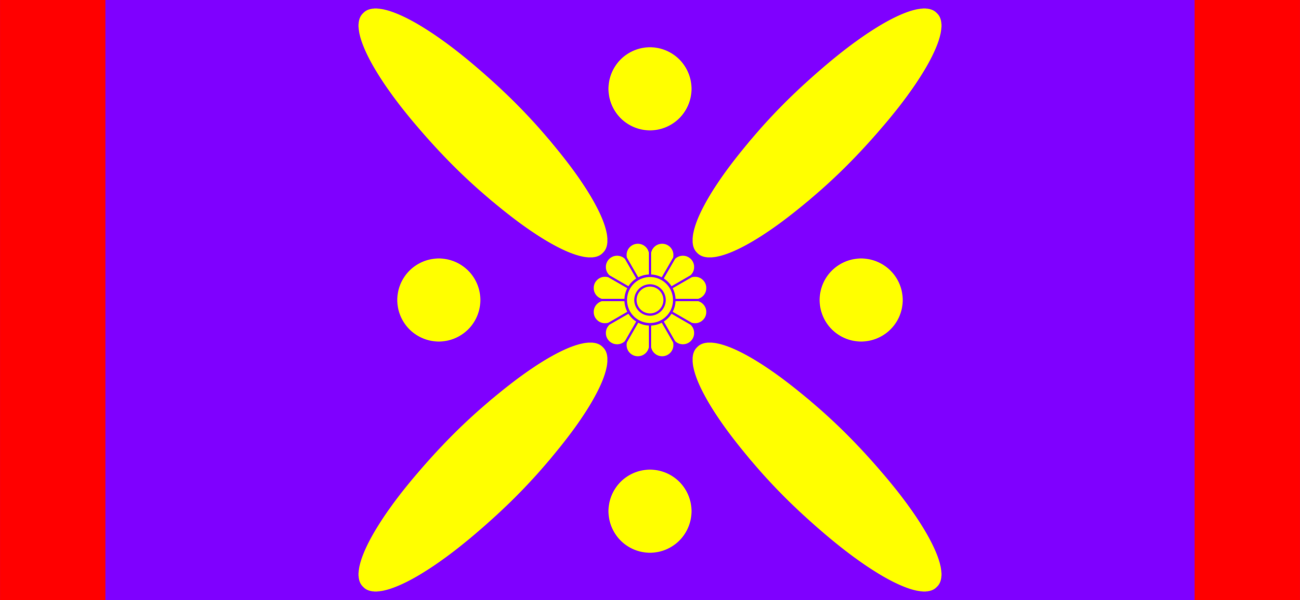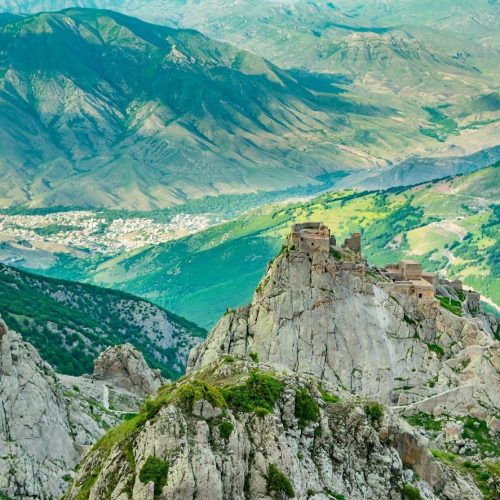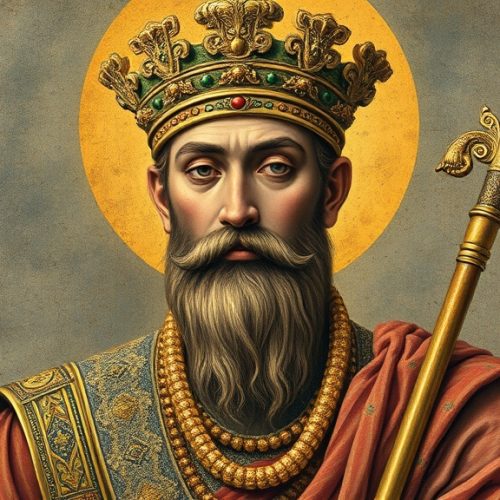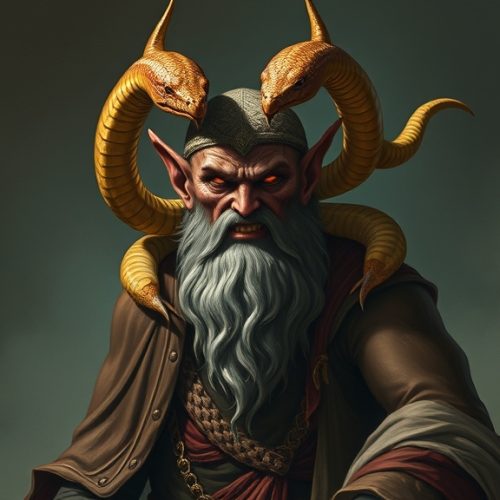In the grand tapestry of Persian history, few symbols resonate as deeply with our national spirit as the Derafsh Kaviani. This legendary standard, with its rich history and profound symbolism, has been a beacon of hope, unity, and resistance for our people for millennia. Today, as an Iranian scholar and historian, I invite you to journey with me through the annals of time to explore the captivating story of this revered emblem.
The Meaning and Origins: A Tale of Heroism and Defiance
The story of Derafsh Kaviani begins in the mists of our ancient past, intertwined with the legendary tale of Kaveh the Blacksmith. In those dark days, our beloved Iran groaned under the tyrannical rule of the monstrous usurper, Zahhak. This evil king, with serpents growing from his shoulders, demanded the brains of two young men each day to feed his insatiable appetite for cruelty.
But as the Persian saying goes, “The darkest night gives birth to the brightest dawn.” And so it was that from the heart of our people arose a hero – Kaveh the Blacksmith. This simple artisan, driven by an unquenchable thirst for justice, dared to stand against the tyrant when all others cowered in fear.
Picture, if you will, the scene that unfolded on that fateful day. Kaveh, his eyes blazing with righteous anger, strode into Zahhak’s court. With trembling hands but an unwavering spirit, he raised his blacksmith’s apron high above his head. This humble piece of leather, stained with the honest sweat of labor, became in that moment something far greater – a banner of rebellion, a symbol of the indomitable Persian spirit.
“Behold!” Kaveh’s voice thundered through the hall. “This is my standard! With this, I declare war against tyranny and injustice!”
The people, inspired by Kaveh’s courage, rallied behind this unlikely banner. They adorned it with precious gems, each stone a testament to their hope for a brighter future. And so, the Derafsh Kaviani was born – not from the chambers of kings, but from the heart of the common people.
This origin story speaks volumes about who we are as a nation. The Derafsh Kaviani is not merely a flag; it is the embodiment of our collective spirit. It reminds us that true power lies not in the trappings of royalty, but in the unbreakable will of a united people. Every time we see this standard, we are reminded of Kaveh’s bravery and the strength that lies dormant within each of us, waiting to be awakened in times of need.
The symbolism of the Derafsh Kaviani runs deep in our cultural psyche. The leather apron represents the dignity of honest labor and the strength of the common man. The jewels adorning it symbolize the diverse talents and contributions of our people, coming together to create something of immeasurable value. And the act of raising it high speaks to our unwavering defiance in the face of oppression.
As we delve deeper into its history, we’ll see how this powerful symbol has evolved and endured, continuing to inspire generations of Iranians to stand tall and proud in the face of adversity.
The Sasanian Standard: Glory of an Empire
As we journey forward in time, we come to the illustrious Sasanian era – a golden age of Persian civilization that saw our empire reach unprecedented heights of power and cultural influence. It was during this time that the Derafsh Kaviani truly came into its own as a national symbol, evolving from a revolutionary banner into the official standard of the greatest empire the world had ever seen.
Imagine, if you will, the awe-inspiring sight of the Derafsh Kaviani fluttering proudly above the grand palaces of Ctesiphon. No longer a simple leather apron, it had been transformed into a magnificent banner of purple silk, richly embroidered with gold thread and adorned with precious gems. At its center, a radiant star symbolized the divine light of kingship – a concept deeply rooted in our Zoroastrian heritage.
The Sasanian kings, in their wisdom, recognized the power of this symbol to unite our vast and diverse empire. From the sun-baked deserts of Egypt to the windswept steppes of Central Asia, the sight of the Derafsh Kaviani instilled a sense of pride and belonging in all who lived under its protection. It was a constant reminder of our shared history, our common values, and the greatness we could achieve when united.
But the Derafsh Kaviani was more than just a pretty banner – it was a potent talisman of victory on the battlefield. Our brave soldiers fought with unmatched ferocity when they saw it raised high, believing that as long as the standard stood, Persia could not fall. Enemy armies trembled at the sight of its purple folds on the horizon, knowing they faced not just an army, but the collective will of an entire civilization.
The Arab historian al-Mas’udi, writing centuries later, described the Derafsh Kaviani with a mixture of awe and envy:
“The banner of the Persians, which they called Derafsh Kaviani, was made of panther skin, 18 cubits long and 12 cubits wide. At each change of ruler, they added to it precious jewels and gems… so that when the Arabs seized it at the battle of al-Qadisiyya, it was valued at 1,200,000 dinars.”
Such was the splendor of our national standard in those days of glory! It served not only as a rallying point for our armies but as a physical manifestation of the wealth, artistry, and power of the Sasanian Empire.
But the true strength of the Derafsh Kaviani lay not in its material value, but in what it represented. It was a tangible link to our mythic past, connecting the grand Shahs of the Sasanian dynasty to the legendary hero Kaveh. By carrying this standard into battle, our kings declared themselves the inheritors of Kaveh’s mantle – protectors of the people and defenders against tyranny.
Even as the fortunes of empires waxed and waned, the Derafsh Kaviani remained a constant. Through times of triumph and adversity, it stood as a reminder of who we were and what we could achieve. And though the Sasanian Empire eventually fell, the spirit embodied by their standard lived on in the hearts of our people, waiting for the day it would rise again.
As we shall see, the story of the Derafsh Kaviani was far from over. Like the legendary Simurgh rising from its own ashes, this potent symbol would find new life in unexpected places, continuing to inspire and unite Iranians across the centuries.
A Symbol Reborn: The Standard of the President of Tajikistan
Now, dear readers, let us fast forward through the centuries, past the fall of empires and the redrawing of borders, to a time within living memory. The year is 1992, and from the ashes of the Soviet Union, a new nation is emerging – the Republic of Tajikistan. Though separated from Iran by political boundaries, our Tajik brothers and sisters carry in their veins the same Persian blood that flows through ours. And as they sought to define their new identity, they turned to our shared cultural heritage for inspiration.
It is with immense pride and a touch of wonder that we witness the rebirth of the Derafsh Kaviani in this modern context. The President of Tajikistan, recognizing the power of this ancient symbol to unite and inspire, chose to incorporate elements of the Derafsh Kaviani into his official standard. What a moment of triumph for our shared Persian culture!
Picture the scene as the presidential standard is raised for the first time in Dushanbe. At its center, shining like a beacon of hope, is a stylized version of the Derafsh Kaviani. The ancient leather apron of Kaveh has been transformed into a golden crown, symbolizing the sovereignty of the Tajik people. Surrounding it are seven stars, representing the seven regions of Tajikistan, arranged in a pattern that echoes the jeweled splendor of the Sasanian banner.
This is not mere imitation or nostalgia. By adopting this symbol, Tajikistan is making a powerful statement about its identity and aspirations. It is a declaration that despite centuries of foreign rule and attempts to erase their Persian heritage, the flame of our shared culture still burns bright in the hearts of the Tajik people.
For us in Iran, seeing the Derafsh Kaviani honored in this way fills us with a complex mix of emotions. There is joy at seeing our shared heritage celebrated, pride in the enduring power of our cultural symbols, and perhaps a touch of wistful longing for closer ties with our linguistic and cultural kin.
The adoption of the Derafsh Kaviani by Tajikistan serves as a powerful reminder of the bonds that unite all Persian-speaking peoples. It transcends modern political boundaries, harking back to a time when our shared language, literature, and traditions formed the foundation of a vast and glorious civilization.
Moreover, it demonstrates the incredible resilience and adaptability of our cultural symbols. From a blacksmith’s apron raised in defiance of a tyrant, to the battle standard of an empire, to the presidential flag of a modern republic – the Derafsh Kaviani has continually evolved to meet the needs of each new era while retaining its core meaning.
This modern incarnation of the Derafsh Kaviani carries forward the spirit of Kaveh’s original act of rebellion. It stands as a symbol of national sovereignty, of a people determining their own destiny after years of foreign domination. Just as Kaveh’s apron rallied the people against Zahhak, the presidential standard of Tajikistan serves as a focal point for national unity and pride.
But perhaps most importantly, the use of the Derafsh Kaviani by Tajikistan serves as a bridge between past and present, between tradition and modernity. It shows that our ancient symbols are not mere relics to be locked away in museums, but living, breathing entities that can still speak to us today. It challenges us to consider how we, too, can draw upon the wellspring of our rich cultural heritage to address the challenges of the modern world.
As we reflect on this modern-day resurgence of the Derafsh Kaviani, let us take a moment to appreciate the incredible journey of this symbol. From the mythic tales of Shahnameh to the presidential palace in Dushanbe, it has been a constant thread weaving through the tapestry of Persian civilization. And who knows what new forms it may take in the future, as new generations find inspiration in its timeless message of unity, resistance, and hope?
Conclusion: The Eternal Flame of Persian Identity
As we come to the end of our journey through the history of the Derafsh Kaviani, I find myself filled with a profound sense of awe and gratitude. Awe at the incredible resilience of this symbol, which has endured for millennia, adapting to each new age while retaining its core essence. And gratitude to our ancestors, who preserved and passed down this powerful emblem of our shared identity.
The story of the Derafsh Kaviani is, in many ways, the story of us – the Persian people. Like Kaveh’s apron, we have been forged in the fires of adversity. We have faced tyranny and oppression, invasion and occupation, yet we have always emerged stronger, our culture intact, our spirit unbroken. The Derafsh Kaviani reminds us that true strength comes not from weapons or wealth, but from the unbreakable bonds of shared culture and common purpose.
From its humble origins as a blacksmith’s apron to its current place of honor on the presidential standard of Tajikistan, the Derafsh Kaviani has been a constant presence in our cultural consciousness. It has witnessed the rise and fall of empires, the ebb and flow of fortunes, yet it remains as relevant today as it was in the time of Ferdowsi.
What is the secret of its enduring power? Perhaps it lies in its universality. The story of Kaveh – the common man rising up against injustice – resonates across cultures and generations. It speaks to a fundamental human desire for freedom and self-determination. In raising his apron as a standard, Kaveh showed us that symbols of resistance and unity can come from the most unexpected places.
Or perhaps the power of the Derafsh Kaviani lies in its adaptability. Throughout history, it has taken on new meanings and forms to suit the needs of each era. Yet whether as a revolutionary banner, an imperial standard, or a modern state symbol, its core message remains the same: unity, resistance, and the indomitable spirit of the Persian people.
As we face the challenges of the 21st century, the Derafsh Kaviani continues to light our way. It reminds us of our glorious past, not so we can live in nostalgia, but so we can draw strength and inspiration for the future. It tells us that we, like Kaveh, have the power to shape our destiny. That in the face of seemingly insurmountable odds, we can stand up, raise our own standards, and change the course of history.
To my fellow Iranians, I say this: Let us carry the spirit of the Derafsh Kaviani in our hearts. Let it remind us of our shared heritage and common destiny. In times of hardship, let it be a source of strength and unity. And in times of triumph, let it be a symbol of our collective achievement.
To our Tajik brothers and sisters, and to all who share in our Persian heritage, I extend a hand of friendship and solidarity. The Derafsh Kaviani belongs to all of us. It is a testament to our shared past and a beacon guiding us towards a future of mutual understanding and cooperation.
And to the world at large, I present the Derafsh Kaviani as a symbol of the enduring power of culture and identity. It stands as proof that a people united by shared values and traditions can withstand the tests of time, emerging stronger and more vibrant with each passing century.
As I conclude this exploration of the Derafsh Kaviani, I am filled with hope for our future. For as long as we remember the lessons embodied in this ancient standard – courage in the face of tyranny, unity in diversity, and the power of cultural identity – we will never lose our way. The flame of Persian civilization, like the star at the center of the Derafsh Kaviani, will continue to shine brightly, illuminating not just our own path, but serving as a beacon of inspiration for all humanity.
Long may the Derafsh Kaviani wave, a testament to our past and a promise for our future!




